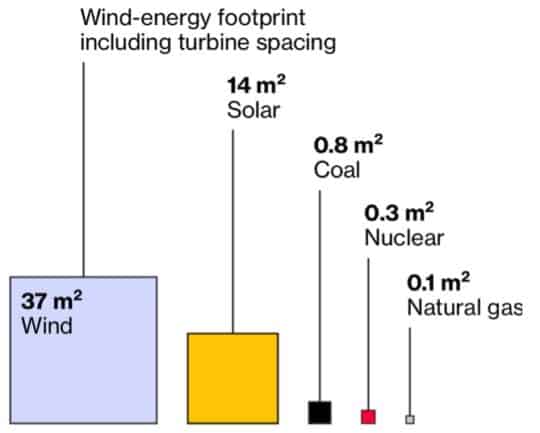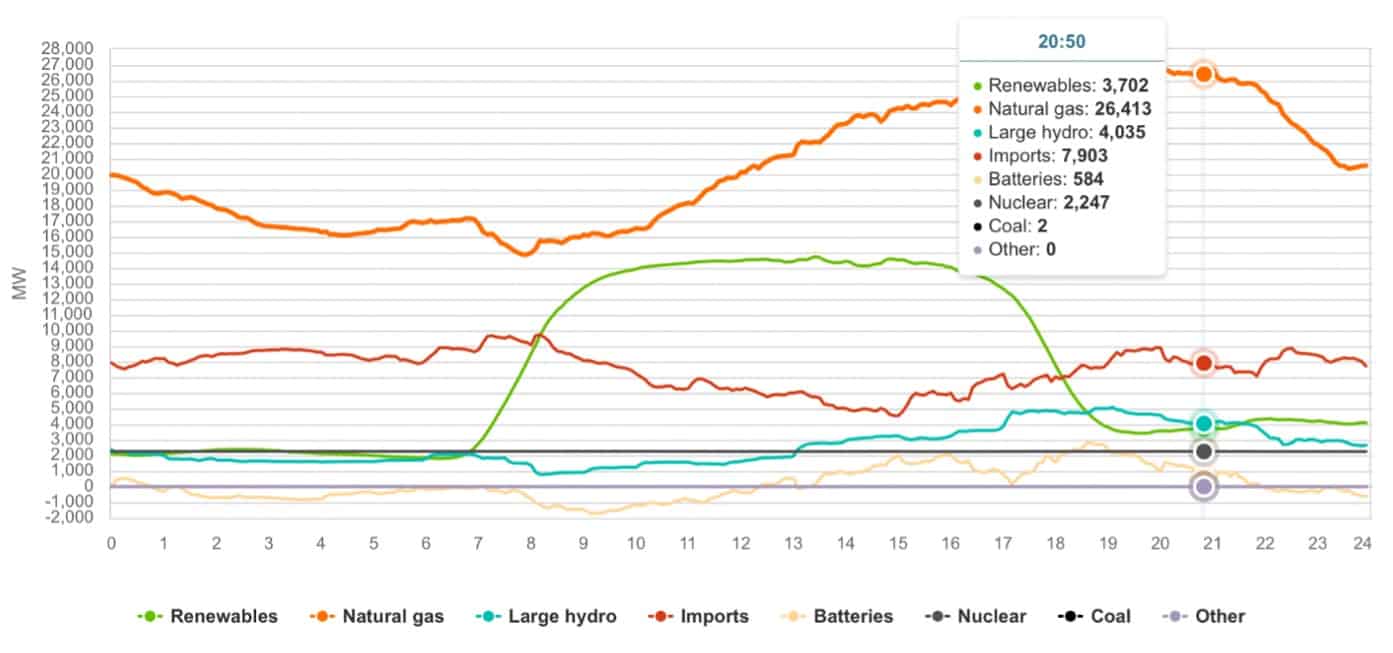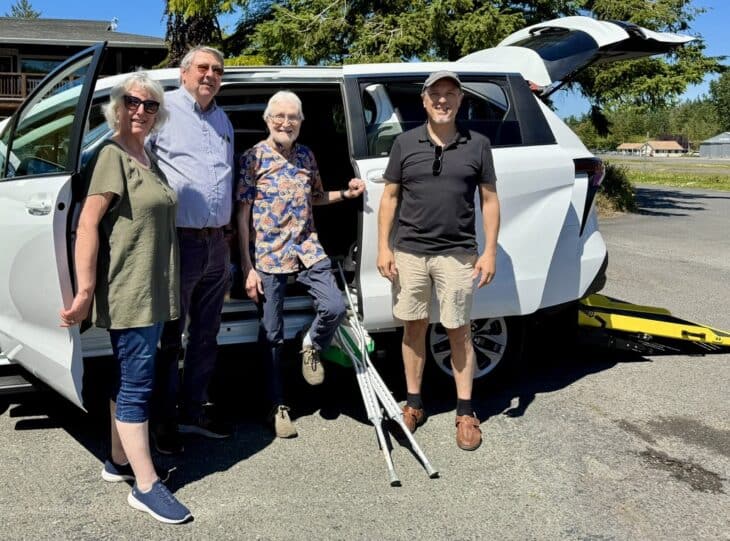Quick Fact: Climate Change News Review – September 2022
As the climate emergency accelerates, energy and decarbonization are becoming regular topics in mainstream news, social media and research. Below, we review several notable items from the past month that provide nuanced insight on some of the vexing challenges OPALCO sees as central to maintaining reliable energy service as the world shifts to net-zero energy systems.
Bloomberg: The U.S. Will Need a Lot of Land for a Zero-Carbon Economy
In this article Bloomberg provides a visually rich analysis of how much land will be needed for new solar, wind, transmission infrastructure. The figure at right illustrates how much land would be needed to power a 100-watt lightbulb. As can be seen, solar and wind power use 140 to 370 times more land than natural gas systems, for example. This topic is showing up more and more as the world shifts from planning to implementation. See more in this in articles below.
The Washington Post: To fight climate change, environmentalists may have to give up a core belief
It gets into the complex realities of building land intensive solar, wind and transmission projects. “To cut U.S. greenhouse gas emissions to zero, experts say, the country is going to have to do something environmentalists have traditionally opposed: It’s going to have to build a lot of energy infrastructure. And fast.”
Science Direct: Sources of opposition to renewable energy projects in the United States
The research paper looks at what’s behind opposition to siting of land intensive energy projects. From the introduction: “Many policy analysts believe that once electricity from renewable energy becomes less expensive than electricity from fossil fuel, new renewable energy facilities will be built quickly across the United States. Cost-effective renewable energy has largely been achieved, but there appear to be substantial barriers to building new renewable energy facilities. We identified 53 utility-scale wind, solar, and geothermal energy projects that were delayed or blocked between 2008 and 2021 in 28 U.S. states. Using multi-level qualitative analysis, we have identified seven key sources of opposition. Of the projects we studied, 34% faced significant delays and difficulties securing permits, 49% were cancelled permanently, and 26% resumed after being stopped for several months or years. Project delays and cancellations account for potential lost generating capacity of almost 4600 MW. State and local governments and renewable energy developers need to pay closer attention to the full range of socially-oriented sources of opposition to new facilities.”
“While analyzing our prototypical case studies, we identified several recurring themes and commonalities. These led to seven distinct hypotheses regarding sources of opposition and barriers to renewable energy development:
- Concerns over possible environmental impacts, including impacts on wildlife
- Challenges to project financing and revenue generation
- Public perceptions of unfair participation processes or inadequate inclusion in light of regulatory requirements
- Failure to respect Tribal rights, including the right to consultation
- Health and safety concerns
- Intergovernmental disputes
- Potential impacts on land and property value”
“Our analysis raises a fundamental question about whether the regulatory systems in place in the US are suited to reviewing the rapidly growing number of new utility-scale renewable energy projects.
We found several instances in which project proponents and opponents were struggling with conflicting federal and state regulations or laws (regarding environmental assessment, facility siting and permitting, along with required public inclusion and Tribal consultation).”
NPR: Why even environmentalists are supporting nuclear power today
With the Ukraine war, Germany and other countries are rethinking nuclear energy. As Russia holds natural gas hostage with winter looming, there are some hard choices Europe is grappling with – burn coal and accelerate the climate emergency, or restart low-carbon nuclear power plants that had been turned off after the Fukushima tsunami. California has similarly vexing energy calculus – keep the Diablo Canyon nuclear power plant running to avoid burning natural gas-powered electric generation plants. See California ISO Energy Dashboard below for related story.
Politico: California hits the gas on electric cars
California regulators approved a rule today banning the sale of new gas-powered cars by 2035. More EVs also mean more charging infrastructure and more electricity use, straining the state’s already-challenged power grid as it undergoes its own transition to cleaner energy (see article above about California rethinking nuclear power.) The state’s new EV rule is a big deal. California is the only state that can regulate vehicle emissions, thanks to a provision of the federal Clean Air Act that offers it a special waiver. Other states can follow California’s rules, and some, including Washington state, New York and Massachusetts, are already poised to do so.
Consumer Reports: More Americans Would “Definitely” Get Electric Vehicles, Survey Shows
The survey finds 71% of Americans express some level of interest in buying or leasing an electric-only vehicle: 14% would “definitely” buy or lease one if they were to get a vehicle today, 22% would “seriously consider” one, and 35% “might” consider one. The 14% of American drivers who say they would “definitely” buy or lease an electric-only vehicle is up markedly from the 4% who said the same in a 2020.
California ISO: Energy Dashboard
California is a leader in transitioning to a net-zero energy system. But with the recent heat waves, they have really had to burn a lot of fossil fuels to stay cool. Their system is dangerously close to red lining. If that happens, they start rolling blackouts. The chart below shows how natural gas (orange line) is their number one energy source, needed especially at night, after the sun has set and solar output falls to zero (green line). Some other things to note: Battery storage charges as the sun rises and solar power ramps up, and discharges in the evening as the sun sets (yellow line). Nuclear is steady, 24/7 (black line).

CivForge: Why Local Climate Planning Has Failed, And What We Can Do To Fix It
San Juan County is in the heart of the Salish Sea, and ground zero for a pristine marine ecosystem that is experiencing enormous stress from climate-driven ocean warming and acidification. All stakeholders (San Juan County, OPALCO, and other key entities) need to be implementing a goal orientated action plan. CivForge, which helps local governments tackle climate change, studied why climate plans fail and how to do better.
Key findings:
- Less than 2 in 5 cities are on track to meet their emissions targets.
- Cities with a climate action plan outperform their peers with no plan, but by far less than you’d expect (they do 31% better but are still underperforming by 318% if they want to reach a 2050 target).
- The average city spends less than 0.5% of its operating budget on climate action. However, the top performing cities spend significantly more on climate action than the average.
- Almost every city’s climate action team is understaffed, but those communities with the most overburdened staff are the least on track to meet their targets.
Many cities start out with good intentions and fail to deliver.
Conclusion
Given all of the articles above, we need to make sure the collective vision of energy resilience and independence, lower carbon emissions, lots of EV chargers, etc. are followed by a strong set of goals, policies and actions that are in alignment with the vision, and consistently pursued at all levels of the county bureaucracy.
OPALCO is committed to supporting County vision and objectives on climate action, energy and decarbonization. OPALCO is looking for a definitive action plan that will accomplish the climate change goals. Which include the following key questions:
- What new energy resources will be needed and supported in the County?
- What’s the plan and timetable?
- How much land will be needed, where, and how long to acquire, NIMBY (not in my backyard), and permit?
- What will it cost, what is source of funds?
- How long will it take to develop?
And as we collaborate with the County, here are some key best practices that have proven effective for other local governments committed to effective climate action:
- Active top-down leadership
- Permitting certainty (short duration)
- Supportive policy and definitive land use allowing renewable generation and efficiency projects
- Funding availability
- Setting Measurable goals
- Regular review of budget goals to actuals



